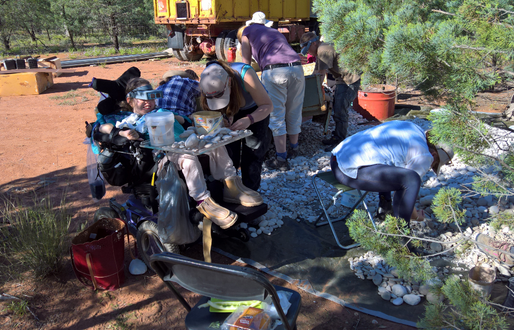
It was a chance encounter with one of UNE’s dinosaur experts Dr Phil Bell on the opal fields of Lightning Ridge that set the wheels in motion, literally, opening the door to a career in palaeontology for Western Australia’s Eleanor Beidatsch.
It had been a dream since she was nine or ten, but one she had previously discounted. Eleanor presumed her advanced physical disability – Spinal Muscular Atrophy Type 1 – and use of a wheelchair would render “digging about in the dirt for fossils” impossible.
Studying marine biology instead was “a happy compromise” but held challenges, too, given that her genetic condition seriously restricted Eleanor’s mobility and she was often dependent on a ventilator. And that’s without further complications associated with scoliosis and osteoporosis.
But the gravitational pull of the earth sciences and the lure of discovering clues to the evolution of life on earth was strong. That’s why Eleanor found herself, in 2016, driving with her family 10,000km across the country to volunteer for an Australian Opal Centre and Australian Geographic dig in the middle of the New South Wales desert.
There, with some help, she donned magnifying goggles to scrutinise rock samples. A marine scientist in training, she found she was particularly good at identifying seashells, and successfully found a number of opalised bivalve shells.
“And that’s where I met Dr Bell and he told me that UNE offered all its palaeontology units online, which sounded pretty cool,” Eleanor says.
It wasn’t long before she was adding UNE palaeontology subjects to her existing study load, and learning that Dr Marissa Betts had a Cambrian-period honours project in the offing.
And the rest, as they say, is history … the history of Cambrian velvet worms, to be exact.

Image: Cambrian Worm fossil
With the support of her UNE supervisors, Dr Betts and Dr Nicolas Campione, Eleanor soon discovered that her disability was no impediment to geoscience honours research into how these velvet worms evolved. In fact, she’s developed something of a niche, mastering the use of sophisticated statistical software to identify species from high-quality images.
“It’s a common misconception that all palaeontology is very physical and takes place in the field; research done in laboratory conditions is quite an uncommon specialisation, but researchers of my kind are highly sought-after,” Eleanor says.
It’s a common misconception that all palaeontology is very physical and takes place in the field; research done in laboratory conditions is quite an uncommon specialisation, but researchers of my kind are highly sought-after.
Dr Campione says palaeontology used to be restricted to field-discovery and organismal classification. "However; over the past several decades, we have seen a shift towards more biological questions and concepts, which has opened the field to many different approaches. Eleanor’s work is therefore breaking barriers, not only socially, but scientifically as well!”
Nevertheless, being a minority in science – both a woman and someone with a disability – has seen Eleanor expose prevailing discrimination and become a strong advocate for intersectionality. And with the addition of journalism units from Deakin University, she has found her voice as an ABC reporter.
“When you are under-represented in your field, even if you don’t intend to make intersectionality a part of your daily life, you are required to advocate for yourself at all times, as someone who can contribute something valuable,” Eleanor says. “I want others to see the importance of inclusivity.
“Nobody should be discriminated against for any type of physical, racial, gender or sexuality difference. None of these have a bearing on your capacity to do a job, to conduct research, to answer scientific questions. These are not true barriers, only perceived barriers by those with an intrinsic bias.”
Nobody should be discriminated against for any type of physical, racial, gender or sexuality difference.
Marissa has become one of Eleanor’s biggest supporters.
“Eleanor is my hero!” she says. “She loves palaeontology and is always thinking of ways to solve scientific problems, and she’s never backed down from a challenge. She’s already had some fantastic achievements – winning UNE’s Keith and Dorothy Mackay Scholarship, the AWG Undergraduate Palaeontology Award and publishing several important articles for the ABC, as well as getting excellent grades.
“UNE’s excellence with online teaching and the serious push COVID gave us really opened our minds to what can be achieved in terms of student research projects by distance. Eleanor is right, there is a strong misconception that palaeontology can only be done 'in the field', but there is a whole field emerging now that uses all manner of online databases, software and technologies to answer palaeontological questions.
“Still, geoscience remains male-dominated and ableist. Neither should be a barrier for learning about how our Earth works or contributing to the field via research or industry. I have no doubt that Eleanor will apply the skills and methods she is learning to all sorts of exciting palaeo problems in the future.”
An article Eleanor recently wrote for the ABC’s digital platform on intersectionality in geoscience has become one of her most popular. You can read it here.


